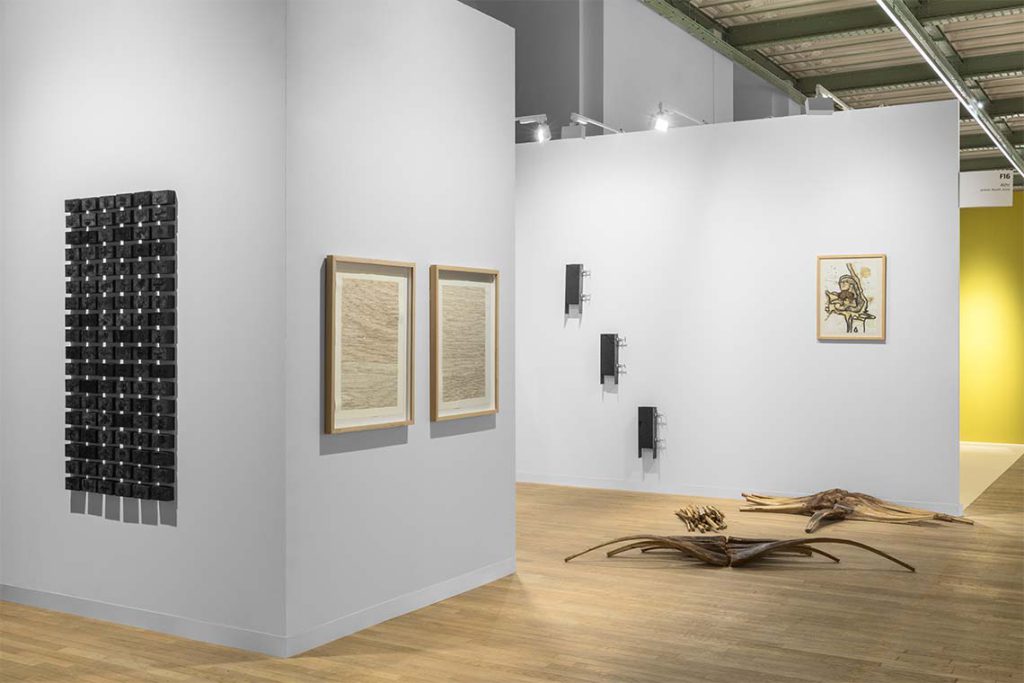Art Basel Paris returns this year to the new location of the Grand Palais. With over 190 galleries under one roof, art from the Arab region stood out with strong participation providing a profound connection to the region’s history and cultural identity.
Arab galleries and artists are places de choix at this year’s Art Basel Paris. Booths by ATHR Gallery (which has spaces in Jeddah, Riyadh and Alula), Loft Art Gallery (Casablanca and Marrakech), and Marfa’ Projects and Sfeir-Semler Gallery from Beirut, showcase works by figures, both old and new, from across the Middle East and North Africa. Collectively, these tell a story of regional traditions and contemporary mores, conflict and hope.
“The public of Art Basel is the right public for these kinds of pieces,” says Yasmine Berrada Sounni, co-owner of Loft, who is presenting a mini-retrospective of works by Mohamed Melehi, the Moroccan Modernist who was a key figure in the Casablanca School movement of the mid-twentieth century. Paintings and collages on view range from his early Art Povera-style pieces, created during his time in Rome in the late-1950s in a muted palette and incorporating found materials, through to hugely vibrant and joyously colourful abstractions completed shortly before his death in 2020.
This is Loft’s inaugural exhibition at the collector-packed event at the Grand Palais, and indeed the first time a gallery from Morocco has been selected for Art Basel Paris. It was important for Loft to begin its participation with Melehi, because he was more than simply one of their artists. “He was also a friend,” says Sounni. “And he always brings us luck.”
ATHR, meanwhile, is looking ahead, with a group showing of mid-career and emerging artists who explore current concerns in Saudi Arabia. These include the natural world and societal shifts, such as the younger generation’s relationship to religion. Artists presented include Muhannad Shono – showing sculptures created from reclaimed black foundry sand – and Mohammad Alfaraj, whose installation of wooden bones ripples across the gallery floor like a runaway fossil.

Audiences who enjoy this kind of eerie and quizzical aesthetic can also visit the Institut du Monde Arabe for a last chance to see ARABOFUTURS, a survey of artists from the Arab world and its diasporas, including Larissa Sansour and Hicham Berrada, who have “embraced speculative fiction to imagine the worlds of tomorrow” (ends 27 October).
Back in the Grand Palais, Marfa’ Projects has paired two artists that work wonderfully together and present a much calmer tone. Seta Manoukian, a Lebanese painter celebrated during the 1970s and 80s, later became a Buddhist nun in Hollywood. She now creates pastel-hued images of life-giving motifs such as eggs and blood. Meanwhile, Paola Yacoub’s small sculptures from the mid-1990s find photographs, playing cards and paper fixed in wax blocks, like moments frozen in time. Seen together, the two artists’ work characterises the ebb and flow of history. Manoukian, who once painted bombed-out ruins during the civil war in Lebanon, now – as she turns 80 – finds solace and inspiration in contemplation and spirituality. Meanwhile, Yacoub’s wax cubes act like effigies of lives lived in a war zone.
The echoes of war resonate profoundly, as Beirut is overcome by conflict once more. “It’s a nightmare,” says Joumana Asseily, director of Marfa Projects. “The gallery is closed. It’s impossible to work. It’s impossible to not even work, you can’t even think. It’s day by day, minute by minute. This is why it’s important to be here and to continue.”
It’s a sentiment endorsed by Ana Siler from Galerie Sfeir-Semler, who says they will persevere, just as they did after their gallery was destroyed by the monumental blast in Beirut’s port in 2020. The gallery opened its space in 2005 – the first ‘white cube’ gallery in the Arab world – and in Paris presents a selection of works by an impressive roster of artists from the region, including Aref El Rayess, Samia Halaby, Yto Barrada, Walid Raad, Wael Shawky, Lawrence Abu Hamdan, Mounira Al Solh, Marwan Rechmaoui and Rayyane Tabet.
One of the booth’s highlights is a large, highly polished stainless steel and geometric wall hanging by the Palestinian-Swedish multi-media artist Tarik Kiswanson, who won the Marcel Duchamp Prize in 2023. The work reflects (pun intended) the railings on the balcony at his grandmother’s house. Rootlessness and loss – Kiswanson’s family were exiled from Jerusalem, via North Africa and Jordan, to Sweden in the early 1980s – lie at the heart of his work. But here, although sharp, the feeling is positive and the work beautiful.
For the people of Beirut, art provides a safe space, says Siler. “For the people living there it’s an exodus, it’s an opportunity to just forget about everything. It’s extremely important in a society like that. You have to offer them something and we are able to do it.”
The subject matter for its artists, she explains, is not just conflict, it is also the lack of an objective historical record in the region. And so, the multiplicity of subjective views offered by artists – political, personal, feminist, art historical – can provide data and details from which a bigger picture can later be formed. “After the deconstruction happening now, the next generation will need that, something to build on.,” she affirms. Presented under the glass dome of the Grand Palais, the visions and views provided by the participating Arab galleries are both timely and valuable.
Art Basel Paris runs until 20 October



